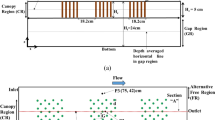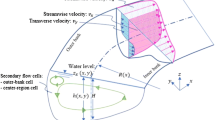Abstract
The present study aims to develop a two-dimensional model for stream-wise mean velocity distribution in a steady, uniform, sediment-laden open-channel turbulent flow considering all the flow velocity components. The derivation starts from the Reynolds-averaged Navier-Stokes (RANS) equation and unlike most of the researchers incorporates the effect of sediment presence in suspension through modified density and viscosity of the sediment-mixed fluid. The resulting partial differential equation is solved numerically using the finite difference method. The model is valid for wide or narrow open channels, and it includes the dip-phenomenon, which is the reason for maximum velocity below the free surface in the case of a narrow open channel. Results show that the cross-sectional velocity contours shift towards the boundary wall with an increase in sediment concentration in the flow and for the case of transverse velocity distribution, the effect of sediment concentration is mainly observed in the main flow region. It is also observed that for smaller aspect ratio, only one circular vortex exists in the secondary circulation and as the aspect ratio increases, the number of circular vortexes also increases. The distribution of velocity along the transverse direction shows a periodic variation due to periodic assumptions in vertical and transverse velocity components, which are appropriate for realistic flow conditions. The model has been validated for centreline velocity distribution along vertical direction by comparing it with relevant data sets for both sediment-mixed fluid and clear fluid. Due to the lack of cross-sectional and transverse velocity distribution data for sediment-mixed fluid in the literature, the model has been verified with clear water laboratory data and also with existing models for clear water flow. Good agreement in all the cases shows the efficiency of the proposed model.
Article highlights
-
A model is formed to study the 2D distribution of stream-wise velocity in an open-channel sediment-laden turbulent flow.
-
The effect of concentration on the transverse and cross-sectional velocity profiles is shown.
-
Velocity profiles are validated with experimental data, which shows good agreement.











Similar content being viewed by others
Availability of data and material
All experimental data have been taken from published papers.
Code availability
MATLAB has been used for coding.
References
Absi R (2011) An ordinary differential equation for velocity distribution and dip-phenomenon in open channel flows. J Hydraul Res 49(1):82–89
Barnes HA, Hutton JF, Walters K (1989) An introduction to rheology. Elsevier 3
Bonakdari H, Larrarte F, Lassabatere L, Joannis C (2008) Turbulent velocity profile in fully-developed open channel flows. Environ Fluid Mech 8(1):1–17
Cellino M, Graf WH (1999) Sediment-laden flow in open-channels under noncapacity and capacity conditions. J Hydraul Eng 125(5):455–462
Cheng NS (1997) Effect of concentration on settling velocity of sediment particles. J Hydraul Eng 123(8):728–731
Coleman JM (1969) Brahmaputra river: channel processes and sedimentation. Sediment geol 3(2–3):129–239
Coleman NL (1981) Velocity profiles with suspended sediment. J Hydraul Res 19(3):211–229
Coleman NL (1986) Effects of suspended sediment on the open-channel velocity distribution. Water Resour Res 22(10):1377–1384
Coleman NL, Alonso CV (1983) Two-dimensional channel flows over rough surfaces. J Hydraul Eng 109(2):175–188
Coles D (1956) The law of the wake in the turbulent boundary layer. J Fluid Mech 1(2):191–226
Colombini M (1993) Turbulence driven secondary flows and the formation of sand ridges. J Fluid Mech 254:701–719. https://doi.org/10.1017/S0022112093002319
Dey S (2014) Fluvial hydrodynamics: hydrodynamic and sediment transport Phenomena. Springer
Einstein H, Chien N (1955) Effects of heavy sediment concentration near the bed on velocity and sediment distribution. report 8. US Army Corps of Engineers, Missouri River Division, University of California, Berkley, California
Elata C, Ippen AT (1961) The dynamics of open channel flow with suspensions of neutrally buoyant particles. Hydrodynamics Laboratory, Department of Civil and Sanitary Engineering
Graf W (1971) Hydraulics of sediment transport. Mc-Graw-Hill, New York, USA
Guo J (1998) Turbulent velocity profiles in clear water and sediment-laden flows. Colorado State University Fort Collins, CO
Guo J (2014) Modified log-wake-law for smooth rectangular open channel flow. J hydraul Res 52(1):121–128
Guo J, Julien PY (2001) Turbulent velocity profiles in sediment-laden flows. J Hydraul Res 39(1):11–23
Guo J, Julien PY (2002) Modified log-wake law in smooth rectangular open-channels. Proc. 13th IAHR-APD Congress Singapore 1, 76-86
Guo J, Julien PY (2003) Modified log-wake law for turbulent flow in smooth pipes. J Hydraul Res 41(5):493–501
Guo J, Julien PY (2008) Application of the modified log-wake law in open-channels. J Appl Fluid Mech 1(2):17–23
Ikeda S (1981) Self-formed straight channels in sandy beds. J Hydraul Div 107(4):389–406
Kundu S (2014) Theoretical study on velocity and suspension concentration in turbulent flow. Ph.D. thesis, IIT Kharagpur
Kundu S (2017) Prediction of velocity-dip-position at the central section of open channels using entropy theory. J Appl Fluid Mech 10(1):221–229
Kundu S, Ghoshal K (2012) An analytical model for velocity distribution and dip-phenomenon in uniform open channel flows. Int J Fluid Mech Res 39(5)
Kundu S, Ghoshal K (2014) Effects of secondary current and stratification on suspension concentration in an open channel flow. Environ Fluid Mech 14(6):1357–1380
Kundu S, Kumbhakar M, Ghoshal K (2018) Reinvestigation on mixing length in an open channel turbulent flow. Acta Geophysica 66(1):93–107
Lassabatere L, Pu JH, Bonakdari H, Joannis C, Larrarte F (2013) Velocity distribution in open channel flows: analytical approach for the outer region. J Hydraul Eng 139(1):37–43
Leighton D, Acrivos A (1987) The shear-induced migration of particles in concentrated suspensions. J Fluid Mech 181:415–439
Lu J, Zhou Y, Zhu Y, Xia J, Wei L (2018) Improved formulae of velocity distributions along the vertical and transverse directions in natural rivers with the sidewall effect. Environ Fluid Mech 18(6):1491–1508
Lu JY (1990) Study on flow velocity distribution in the yangtze river riverflow. J Yangtze River Sci Res Inst 1:40–49
Mohan S, Kumbhakar M, Ghoshal K, Kumar J (2019) Semianalytical solution for simultaneous distribution of fluid velocity and sediment concentration in open-channel flow. J Eng Mech 145(11):04019090
Mohan S, Kundu S, Ghoshal K, Kumar J (2021) Numerical study on two dimensional distribution of streamwise velocity in open channel turbulent flows with secondary current effect. Arch Mech 73(2)
Montes Videla JS (1973) Interaction of two dimensional turbulent flow with suspended particles. Mass Inst Technol
Muste M, Patel V (1997) Velocity profiles for particles and liquid in open-channel flow with suspended sediment. J Hydraul Eng 123(9):742–751
Nezu I, Nakagawa H (1993) Turbulence in open-channel flows, iahr monograph series. AA Balkema, Rotterdam, pp 1–281
Nezu I, Rodi W (1985) Experimental study on secondary currents in open-channel flow. 21st Congress of IAHR, Melbourne, Australia, pp 114–119
Pal D, Ghoshal K (2013) Hindered settling with an apparent particle diameter concept. Adv water Resour 60:178–187
Prandtl L (1932) Recent results of turbulence research. Technical Memorandum 720. National Advisory Committee for Aeronautics
Prandtl L (1952) Essentials of fluid dynamics: with applications to hydraulics. Aeronautics, Meteorology and other Subjects: Bombay, Blackie & Son, Ltd
Pu J (2013) Universal velocity distribution for smooth and rough open channel flows. J Appl Fluid Mech 6(3):413–423
Rouse H (1937) Modern concepts of the mechanics of turbulence. Trans ASCE 102:463–543
Sarma KV, Lakshminarayana P, Rao NL (1983) Velocity distribution in smooth rectangular open channels. J Hydraul Eng 109(2):270–289
Sarma KV, Prasad BVR, Sarma AK (2000) Detailed study of binary law for open channels. J Hydraul Eng 126(3):210–214
Tominaga A, Nezu I, Ezaki K, Nakagawa H (1989) Three-dimensional turbulent structure in straight open channel flows. J Hydraul Res 27(1):149–173
Umeyama M, Gerritsen F (1992) Velocity distribution in uniform sediment-laden flow. J Hydraul Eng 118(2):229–245
Vanoni VA (1940) Experiments on the transportation of suspended sediment by water. Calif Insti Technol
Vanoni VA, Nomicos GN (1960) Resistance properties of sediment-laden streams. Trans Am Soc Civil Eng 125(1):1140–1167
Von Kármán T (1930) Mechanische änlichkeit und turbulenz. Nachrichten von der Gesellschaft der Wissenschaften zu Göttingen, Mathematisch-Physikalische Klasse 1930:58–76
Wang ZQ, Cheng NS (2005) Secondary flows over artificial bed strips. Adv Water Resour 28(5):441–450
Wang ZQ, Cheng NS (2006) Time-mean structure of secondary flows in open channel with longitudinal bedforms. Adv Water Resour 29(11):1634–1649
Yang SQ (2007) Turbulent transfer mechanism in sediment-laden flow. J Geophys Res 112:F01005https://doi.org/10.1029/2005JF000452
Yang SQ (2009) Influence of sediment and secondary currents on velocity. Water Manag 162(5):299–307
Yang SQ, Tan SK, Lim SY (2004) Velocity distribution and dip-phenomenon in smooth uniform open channel flows. J Hdraul Eng 130(12):1179–1186
Yang SQ, Tan SK, Wang XK (2012) Mechanism of secondary currents in open channel flows. J Geophys Res: Earth Surf 117(F4)
Funding
Not applicable.
Author information
Authors and Affiliations
Contributions
All authors’ have actively participated in developing the model and performing the solution.
Corresponding author
Ethics declarations
Conflicts of interest
There are no conflicts of interest among the authors’.
Additional information
Publisher's Note
Springer Nature remains neutral with regard to jurisdictional claims in published maps and institutional affiliations.
Rights and permissions
About this article
Cite this article
Kundu, S., Sen, S., Mohan, S. et al. Two-dimensional distribution of stream-wise mean velocity in turbulent flow with effect of suspended sediment concentration. Environ Fluid Mech 22, 133–158 (2022). https://doi.org/10.1007/s10652-022-09834-9
Received:
Accepted:
Published:
Issue Date:
DOI: https://doi.org/10.1007/s10652-022-09834-9




